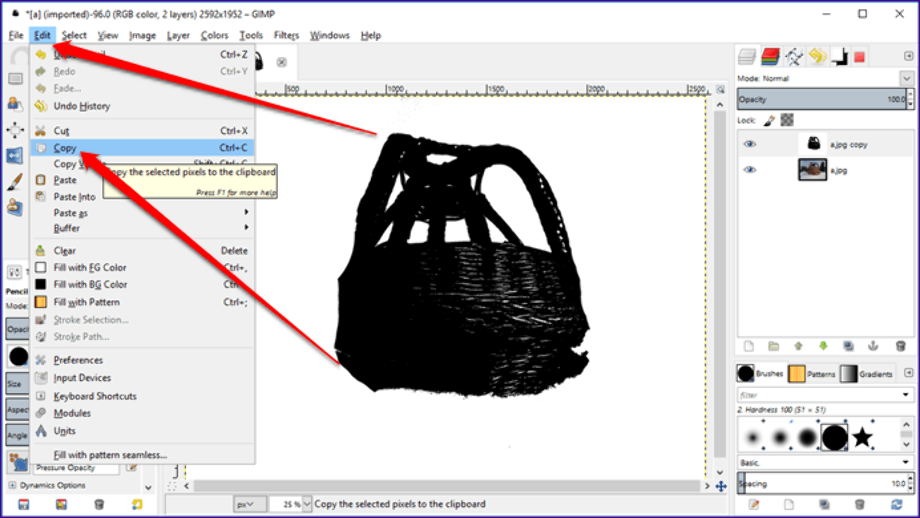

- #Gimp transparent background move to layer registration
- #Gimp transparent background move to layer license
Open the image you want to add the alpha channel to in gimp.Then paste the copied alpha channel to the desired image with the following steps: From the menu, select " Edit -> Copy Visible".A new image is opened, from the layers window, delete (right click, " Delete Layer") or hide (left click on the first thumbnail button) the unwanted layers.
#Gimp transparent background move to layer registration
From the popup window, select the color model (RGB or RGBA), ensure " Decompose as layers" is checked, and " Foreground as registration color" is unchecked.From the menu, select " Color -> Components -> Decompose".Open the image you want to use as an alpha channel (or that it contains the alpha channel you want to use) in gimp.First let's copy the alpha channel to be used later with the following steps: The guide assumes the alpha channel is to be found as a component of another image. In any case, whichever method you used, the result should look like this (actual transparent PNG on left, with checkered background on answer is correct but assumes a little bit of gimp knowledge, so I am writing a step by step guide here, so it's easier to follow for people with zero gimp knowledge. Then optionally apply the mask as in method 1. on the base image layer and choose "Selection" from the dialog. Method 3: As method 2, but after Channel to Selection, don't invert the selection, but simply use Layer → Mask → Add Layer Mask. Add an alpha channel for it with Layers → Transparency → Add Alpha Channel if it doesn't have one already, and then cut the selection away from the layer ( Select → Cut or Ctrl+ X). Select the base image layer in the Layers dialog. Invert the selection with Select → Invert or Ctrl+ I. With the grayscale image layer visible, open the Channels dialog, right-click one of the Red/Green/Blue channels (they should all be identical) and select Channel to Selection. Method 2: Open the images as layers ( File → Open as Layers.) or just paste one as a new layer into the other. Optionally, turn the layer mask into an actual alpha channel using Layer → Mask → Apply Layer Mask (but simply exporting the image as PNG will do that for you). Paste the grayscale image in ( Edit → Paste or Ctrl+ V) and anchor the resulting floating selection into the mask ( Layers → Anchor Layer or Ctrl+ H, or click the Anchor icon in the Layers dialog). The layer mask you just added should be selected for editing if not, select it with Layer → Mask → Edit Layer Mask (or just click the mask in the Layers dialog).

It doesn't matter what you choose as the mask, since we'll be replacing it shortly. (also available by right-clicking the layer in the Layers dialog). On the base image, select Layer → Mask → Add Layer Mask. Select the grayscale image and copy it to the clipboard ( Edit → Copy or Ctrl+ C). There are several ways to do this let me describe a few of them.
#Gimp transparent background move to layer license
(Base image based on this photo by John Fielding, used under the CC-By-SA 2.0 license alpha mask created by me using the GIMP's Sphere Designer tool.) When you've done this a couple of times and there's no white or grey left in the image, you can merge that layer down as well to have the whole foreground on one layer.OK, so I assume you have two images: a normal image that you want to add transparency to, and a grayscale image that you want to use as its alpha (transparency) channel, something like these: Maybe duplicate it even more times, merging them down unto the layer immediately above the bottom layer. Then duplicate the new layer and merge it down (from its right click menu). The set the mode of the new layer to multiply. If you can't see the tool options, you can add it from the dockable dialogs submenu of the window menu.ĥ) Clear it (press delete on the keyboard, or select clear from the edit menu).Ħ) (optional) Duplicate the layer using its right click menu or ctrl-shift-d. You can also use the option in the layer menu.Ģ) Select the "select by color" tool (shift-o).ģ) You may want to adjust the tool options, especially the thresold. To do this, you may need to right click on the layer (Ctrl-l if the list of layers isn't visible), then click "add alpha channel" if it isn't greyed out. This method kind of assumes you're using a black foreground on a white background, and wouldn't work for other colour combinations unless you change the last step.ġ) Ensure the layer has transparency enabled. Also, you could apply those tools after the color-to-alpha if the text had somehow got grey edges.Īlternatively, you can use the select by color tool. The colors menu has tools such as brightness-contrast and curves which you could use to increase the difference before the change. It could be done with the color to alpha tool from the color menu, assuming the foreground and background colours are different enough from each other (as they should be for black text on a white background.


 0 kommentar(er)
0 kommentar(er)
